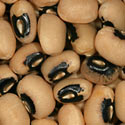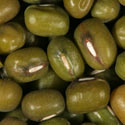|
Genus: Vigna Life
> eukaryotes >
Archaeoplastida >
Chloroplastida
>
Charophyta > Streptophytina > Plantae (land plants)
> Tracheophyta (vascular plants) > Euphyllophyta > Lignophyta (woody plants)
> Spermatophyta (seed plants) > Angiospermae (flowering
plants) > Eudicotyledons > Core Eudicots > Rosids >
Eurosid I > Fabales > Family: Fabaceae > Subfamily: Papilionoideae
About
160 species, widespread in tropical regions, with 20 species native
to southern Africa, one species is naturalised, and a further three
species are cultivated in the region.
Species native to southern Africa
List from
Plants of
southern Africa - an online checklist (SANBI),
Flora of Zimbabwe
and Flora of
Mozambique.
Vigna antunesii
Recorded from Zimbabwe and Mozambique. |
 |
Vigna friesiorum |
|
Vigna frutescens
|
 |
Vigna gazensis |
 |
Vigna juncea
Recorded from Zimbabwe. |
|
Vigna kokii |
|
Vigna luteola |
|
Vigna marina
|
|
Vigna monophylla |
|
Vigna mudenia
|
|
Vigna nyangensis
Recorded from Zimbabwe. |
|
Vigna oblongifolia
|
|
Vigna pygmaea |
|
Vigna radiata
Recorded from Zimbabwe and Mozambique. |
|
Vigna radicans
Recorded from Zimbabwe. |
|
Vigna reticulata
Recorded from Zimbabwe. |
|
Vigna scabrida |
|
Vigna schlechteri
[= Vigna nervosa] |
|
Vigna unguiculata (Cowpea,
Asparagus bean, Yard-long bean) Native to Africa, including southern Africa. It is an
important commercial crop in Africa and is also grown as a subsistence crop.
Besides the seeds, the leaves and young pods are also eaten and are
considered nutritious. |
 |
Vigna vexillata
[= Vigna lobatifolia] See Flora
of Zimbabwe, where it split into two variations -
var. vexillata and
var. angustifolia.
|
 |
Species naturalised in southern Africa
List from
Plants of southern Africa (POSA)
- an online checklist (SANBI).
Other species, cultivated in southern Africa
|
Vigna caracalla (Snail vine, Snail flower)
Native to tropical South America. |
|
|
Vigna radiata (Mung bean)
Mung beans originate from India and India remains a
leading producer of this legume. Most mung beans are olive green in colour but
they can also be yellow, brown, or mottled black. They are an excellent source
of folic acid and a good source of magnesium, phosphorus and thiamin. Mung
beans are an important food in rural areas of southern Africa, where the dry
bean seeds are used or the beans themselves are eaten as a vegetable. |
 |
|
Vigna subterranea (Jugo
bean, Bambara groundnut, African groundnut) |
 |
|
